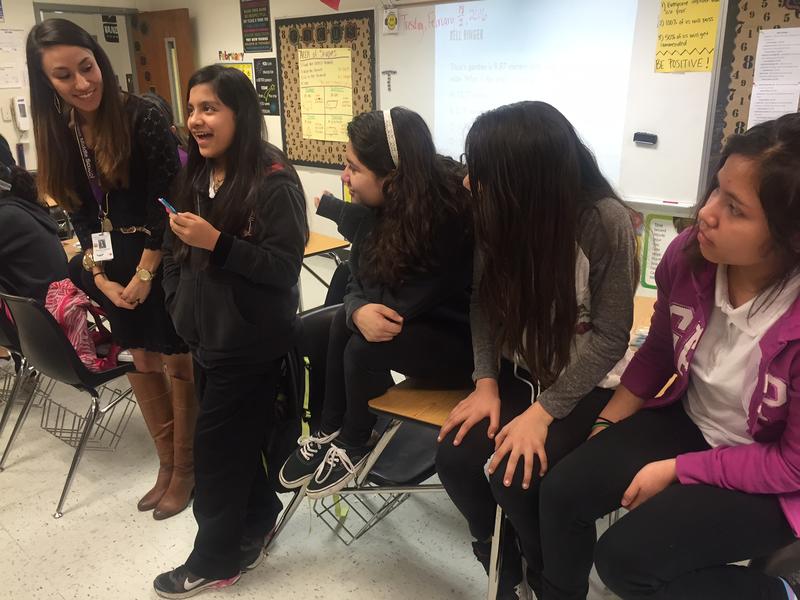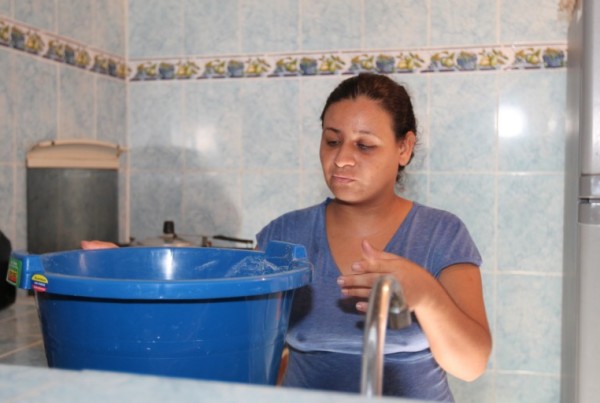This story originally appeared on KERA News.
It’s mid-morning, and the hallways at Medrano Middle School are bustling with sixth graders as they head to their next class.
Before diving into math lessons, teacher Amanda Tanguma has some other plans for her students. She tells them to gather in a circle. The students push their desks out of the way and stand together to talk about a topic that’s a big issue these days – bullying.
“Maybe your experiences with bullying,” Tanguma said. “Or maybe you’ve seen it, or maybe you actually might have accidentally or purposefully bullied someone yourself.”
The students pass around a colorful star. They call it a “talking piece.” Only the person holding the piece can talk while everyone else listens.
Some students are a bit shy about sharing their experiences. Others are eager to talk and have a lot to say.
“It’s bad because when you see someone get bullied, you wanna help them,” said one girl. “But you know that if you try to help, you might end up getting bullied yourself and that’s something that people need to do is start standing up.”
This isn’t group therapy — these circles form the foundation for what’s called restorative discipline. And this scene is happening in more classrooms around the country. Not long ago, zero tolerance was a popular way to discipline students. But studies show minority students are suspended or expelled at rates higher than white students. This new approach aims to tackle problems before they blow up into bad behavior.
“The goal of restorative discipline really is to build relationships with teachers and students and also help them,” said Dallas Gutierrez, sixth grade assistant principal at Medrano. “If they can have the relationships there, then you’re gonna see less discipline referrals, you’re gonna see more kids on task, and you’re gonna have a more positive learning environment.”
The Dallas school district launched its restorative discipline pilot program last fall. It’s at two elementary schools and four middle schools, including Medrano.
Teachers are required to gather in a circle with students once every six weeks, but some classes gather more often. When they form these circles, teachers say, students get tot know their classmates better and feel more comfortable talking about problems like bullying. Sometimes the circle consists of a teacher, student and a students’ parents.
Gutierrez admits he was skeptical about the concept at first. He now believes the practice is having an impact because teachers are taking the time to build relationships with all of their students, not a select few.
“I think when you implement restorative discipline, it really opens your eyes to what your students are really facing at home and here at school and the peer pressure that they’re under or the bullying that you weren’t aware of,” Gutierrez said. “And so that gives you a better perspective of how to tackle certain issues with students.”
Jay Sheets, who coordinates in-school suspension and restorative discipline for the district, said the pilot program is having a positive effect.
So far, this school year, in-school suspension at the pilot schools has dropped by 70 percent and out-of-school suspension by 77 percent. The number of students being sent to alternative school has been cut in half.
Sheets said restorative discipline allows students to create bonds because they’re sharing personal stories.
“A lot of the teachers don’t live in the neighborhoods that the schools are in,” Sheets said. “When we drive in, just because we have a student in our classroom doesn’t necessarily mean we know what’s going on with that student. This give the teachers a chance to hear it straight from the students’ mouth.”
Back at Medrano, Amanda Tanguma challenges her student to think critically about how to tackle the problem of bullying.
“What do think could be done aside from telling a teacher?” she asked them. “What could you personally do and maybe what are the risks of that?”
A few of the students talk about approaching the bully.
“Talk to them because sometimes they’re going through something and you need to talk to them to make them feel like you’re there for them and they don’t need to be bullying,” said one girl.
Dallas plans to expand restorative discipline to four more elementary schools and two more middle schools next year. It’s also going beyond Dallas. Other North Texas school districts have reached out to learn how to get their students to form circles — to talk — instead of fight with each other.
















